2003 NISSAN FRONTIER child restraint
[x] Cancel search: child restraintPage 1 of 272
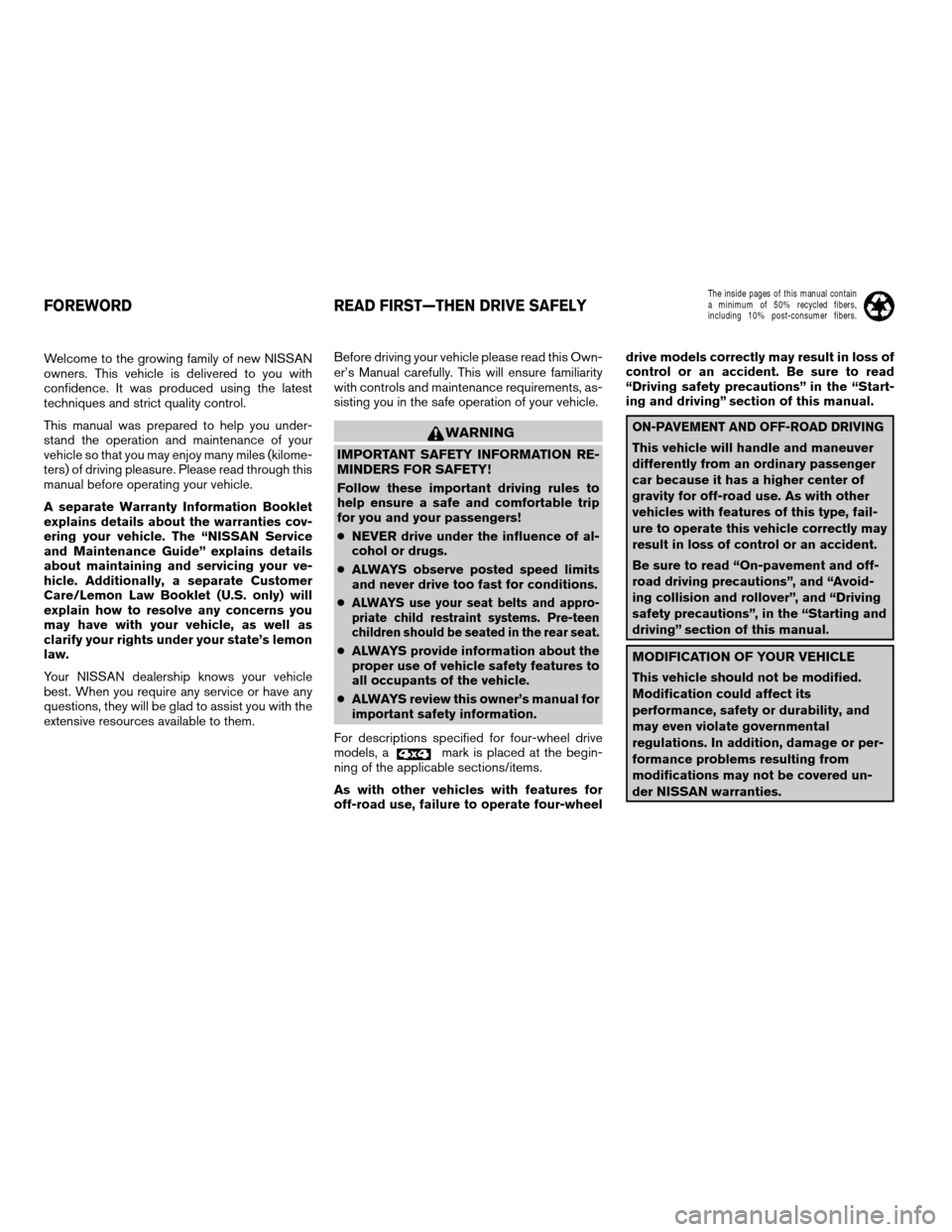
Welcome to the growing family of new NISSAN
owners. This vehicle is delivered to you with
confidence. It was produced using the latest
techniques and strict quality control.
This manual was prepared to help you under-
stand the operation and maintenance of your
vehicle so that you may enjoy many miles (kilome-
ters) of driving pleasure. Please read through this
manual before operating your vehicle.
A separate Warranty Information Booklet
explains details about the warranties cov-
ering your vehicle. The “NISSAN Service
and Maintenance Guide” explains details
about maintaining and servicing your ve-
hicle. Additionally, a separate Customer
Care/Lemon Law Booklet (U.S. only) will
explain how to resolve any concerns you
may have with your vehicle, as well as
clarify your rights under your state’s lemon
law.
Your NISSAN dealership knows your vehicle
best. When you require any service or have any
questions, they will be glad to assist you with the
extensive resources available to them.Before driving your vehicle please read this Own-
er’s Manual carefully. This will ensure familiarity
with controls and maintenance requirements, as-
sisting you in the safe operation of your vehicle.
WARNING
IMPORTANT SAFETY INFORMATION RE-
MINDERS FOR SAFETY!
Follow these important driving rules to
help ensure a safe and comfortable trip
for you and your passengers!
cNEVER drive under the influence of al-
cohol or drugs.
cALWAYS observe posted speed limits
and never drive too fast for conditions.
c
ALWAYS use your seat belts and appro-
priate child restraint systems. Pre-teen
children should be seated in the rear seat.
cALWAYS provide information about the
proper use of vehicle safety features to
all occupants of the vehicle.
cALWAYS review this owner’s manual for
important safety information.
For descriptions specified for four-wheel drive
models, a
mark is placed at the begin-
ning of the applicable sections/items.
As with other vehicles with features for
off-road use, failure to operate four-wheeldrive models correctly may result in loss of
control or an accident. Be sure to read
“Driving safety precautions” in the “Start-
ing and driving” section of this manual.
ON-PAVEMENT AND OFF-ROAD DRIVING
This vehicle will handle and maneuver
differently from an ordinary passenger
car because it has a higher center of
gravity for off-road use. As with other
vehicles with features of this type, fail-
ure to operate this vehicle correctly may
result in loss of control or an accident.
Be sure to read “On-pavement and off-
road driving precautions”, and “Avoid-
ing collision and rollover”, and “Driving
safety precautions”, in the “Starting and
driving” section of this manual.
MODIFICATION OF YOUR VEHICLE
This vehicle should not be modified.
Modification could affect its
performance, safety or durability, and
may even violate governmental
regulations. In addition, damage or per-
formance problems resulting from
modifications may not be covered un-
der NISSAN warranties.
FOREWORD READ FIRST—THEN DRIVE SAFELY
ZREVIEW COPY:Ð2003 Truck/Frontier(d22)
Owners Manual(owners)ÐUSA English(nna)
01/13/03Ðarosenma
X
The inside pages of this manual contain
a minimum of 50% recycled fibers,
including 10% post-consumer fibers.
Page 7 of 272

1 Seats, restraints and supplemental air
bag systems
Seats............................................1-2
Front manual seat adjustment....................1-2
Tilting rear bench seat (Crew Cab models
only)..........................................1-4
Jump seat (if so equipped).......................1-5
Head restraint adjustment.......................1-5
Supplemental restraint system......................1-6
Precautions on supplemental restraint sys-
tem ...........................................1-6
Passenger supplemental air bag on/off
switch and light (except Crew Cab models)......1-15
Supplemental air bag warning labels.............1-17
Supplemental air bag warning light..............1-17
Seat belts.......................................1-19
Precautions on seat belt usage..................1-19
Child safety...................................1-21
Pregnant women..............................1-23Injured persons................................1-23
Three-point type seat belt with retractor..........1-23
Two-point type seat belt without retractor
(jump seat in King Cab models and center of
rear seat in Crew Cab models)..................1-26
Seat belt extenders............................1-28
Seat belt maintenance.........................1-28
Child restraints...................................1-29
Precautions on child restraints..................1-29
Installation on rear bench seat center
position (Crew Cab models only)................1-31
Installation on rear bench seat outboard
positions (Crew Cab models only)...............1-34
LATCH~lower anchors and tether for children!
system..........................................1-38
Top tether strap child restraint..................1-40
Installation on front passenger seat..............1-41
ZREVIEW COPY:Ð2003 Truck/Frontier(d22)
Owners Manual(owners)ÐUSA English(nna)
01/15/03Ðarosenma
X
Page 11 of 272
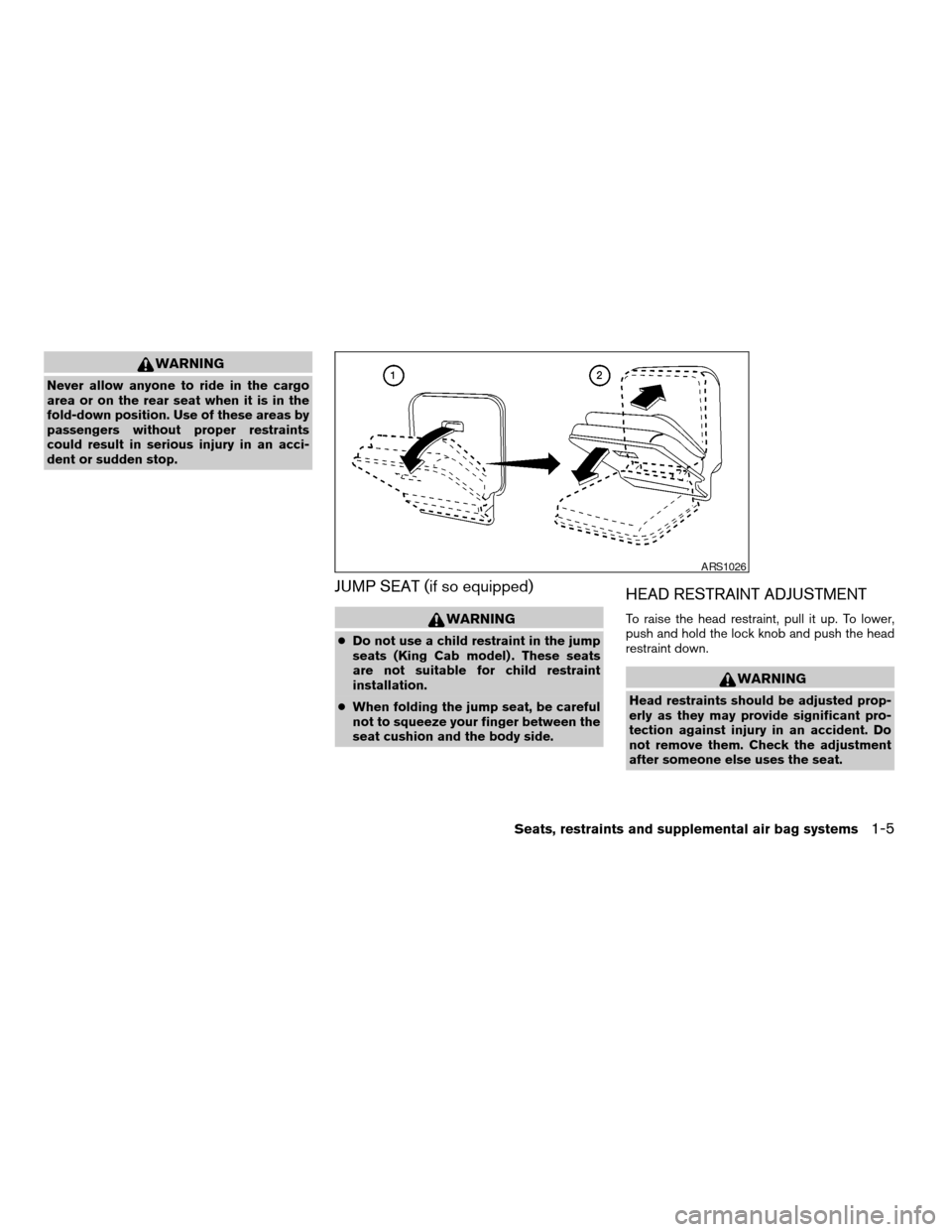
WARNING
Never allow anyone to ride in the cargo
area or on the rear seat when it is in the
fold-down position. Use of these areas by
passengers without proper restraints
could result in serious injury in an acci-
dent or sudden stop.
JUMP SEAT (if so equipped)
WARNING
cDo not use a child restraint in the jump
seats (King Cab model) . These seats
are not suitable for child restraint
installation.
cWhen folding the jump seat, be careful
not to squeeze your finger between the
seat cushion and the body side.
HEAD RESTRAINT ADJUSTMENT
To raise the head restraint, pull it up. To lower,
push and hold the lock knob and push the head
restraint down.
WARNING
Head restraints should be adjusted prop-
erly as they may provide significant pro-
tection against injury in an accident. Do
not remove them. Check the adjustment
after someone else uses the seat.
ARS1026
Seats, restraints and supplemental air bag systems1-5
ZREVIEW COPY:Ð2003 Truck/Frontier(d22)
Owners Manual(owners)ÐUSA English(nna)
01/13/03Ðarosenma
X
Page 14 of 272
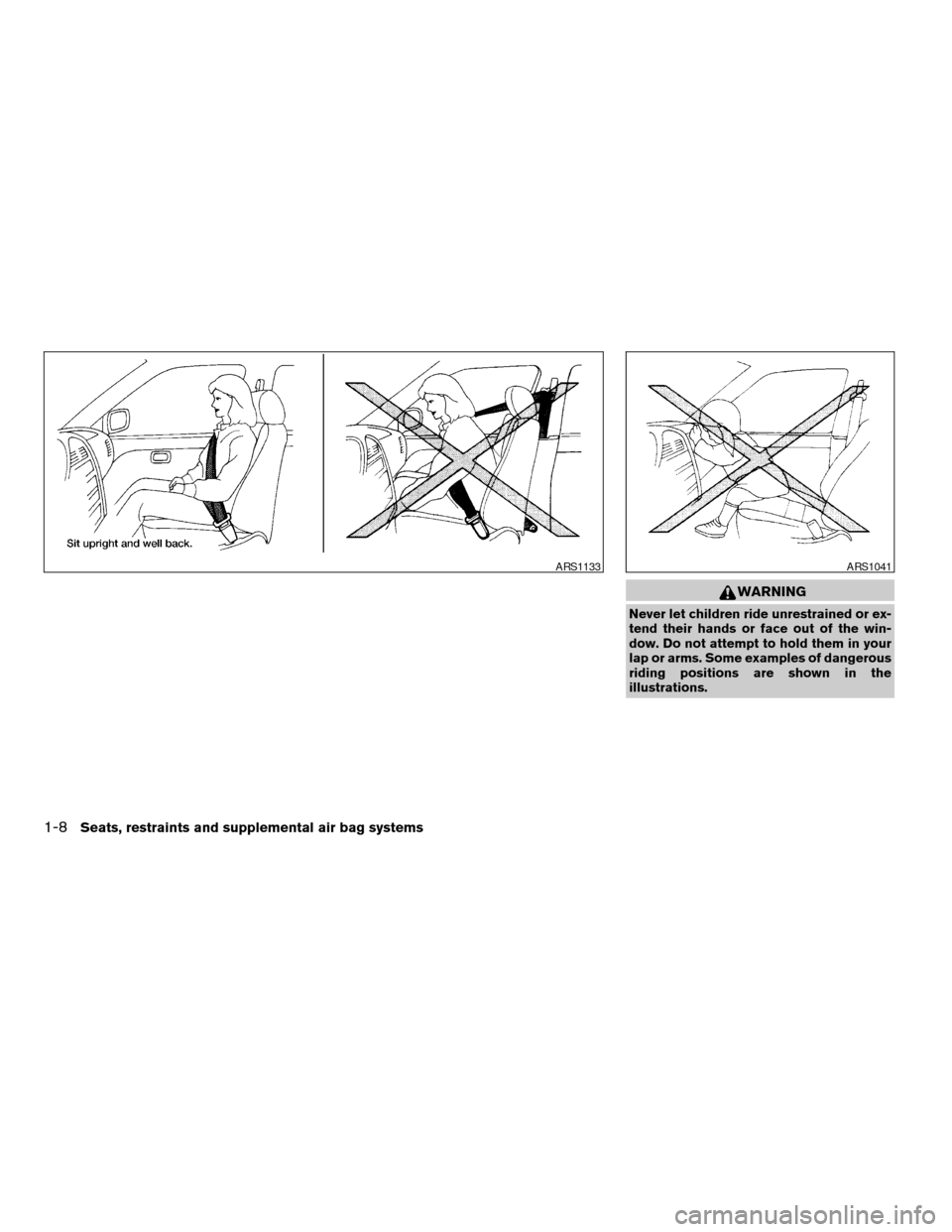
WARNING
Never let children ride unrestrained or ex-
tend their hands or face out of the win-
dow. Do not attempt to hold them in your
lap or arms. Some examples of dangerous
riding positions are shown in the
illustrations.
ARS1133ARS1041
1-8Seats, restraints and supplemental air bag systems
ZREVIEW COPY:Ð2003 Truck/Frontier(d22)
Owners Manual(owners)ÐUSA English(nna)
01/13/03Ðarosenma
X
Page 16 of 272
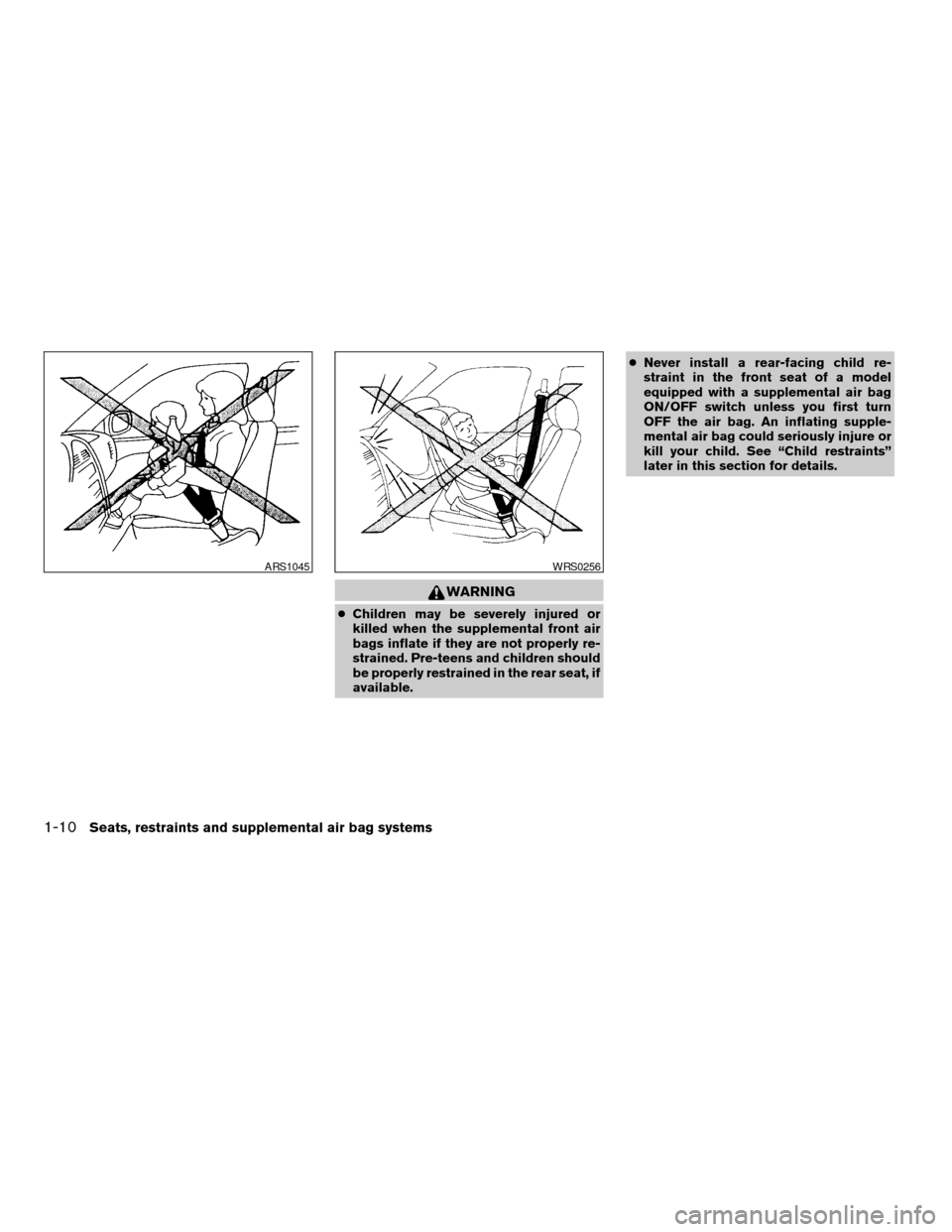
WARNING
cChildren may be severely injured or
killed when the supplemental front air
bags inflate if they are not properly re-
strained. Pre-teens and children should
be properly restrained in the rear seat, if
available.cNever install a rear-facing child re-
straint in the front seat of a model
equipped with a supplemental air bag
ON/OFF switch unless you first turn
OFF the air bag. An inflating supple-
mental air bag could seriously injure or
kill your child. See “Child restraints”
later in this section for details.
ARS1045WRS0256
1-10Seats, restraints and supplemental air bag systems
ZREVIEW COPY:Ð2003 Truck/Frontier(d22)
Owners Manual(owners)ÐUSA English(nna)
01/13/03Ðarosenma
X
Page 17 of 272

1. Diagnosis sensor unit
2. Seat belt pre-tensioner retractors
3. Supplemental air bag modules
4. Passenger air bag ON/OFF switch
5. Passenger air bag OFF indicatorSupplemental front air bag system
The driver supplemental front air bag is located in
the center of the steering wheel. The passenger
supplemental front air bag is mounted in the
dashboard above the glove box.These systems are designed to meet optional
certification requirements under U.S. regulations.
They are also permitted in Canada. The optional
certification allows the front air bags to be de-
signed to inflate somewhat less forcefully than
previously.However, all of the information,
cautions and warnings in this manual still
apply and must be followed.
The supplemental front air bag system is de-
signed to inflate in higher severity frontal colli-
sions, although it may inflate if the forces in an-
other type of collision are similar to those of a
higher severity frontal impact. It may not inflate in
certain frontal collisions. Vehicle damage (or lack
of it) is not always an indication of proper supple-
mental front air bag system operation.
King Cab models are equipped with a supple-
mental front passenger air bag ON/OFF switch.
Because no rear seat exists where a rear facing
child restraint can be secured as in other models,
the switch is designed to turn OFF the passenger
supplemental air bag so that a rear facing child
restraint can be used in the front passenger seat.
See “Passenger supplemental air bag ON/OFF
switch and light” later in this section for details.
Crew Cab models are not equipped with a
supplemental front passenger air bag ON/OFF
switch because they have a rear seat for child
restraint installation. Further, for Crew Cab mod-
WRS0214
Seats, restraints and supplemental air bag systems1-11
ZREVIEW COPY:Ð2003 Truck/Frontier(d22)
Owners Manual(owners)ÐUSA English(nna)
01/13/03Ðarosenma
X
Page 21 of 272
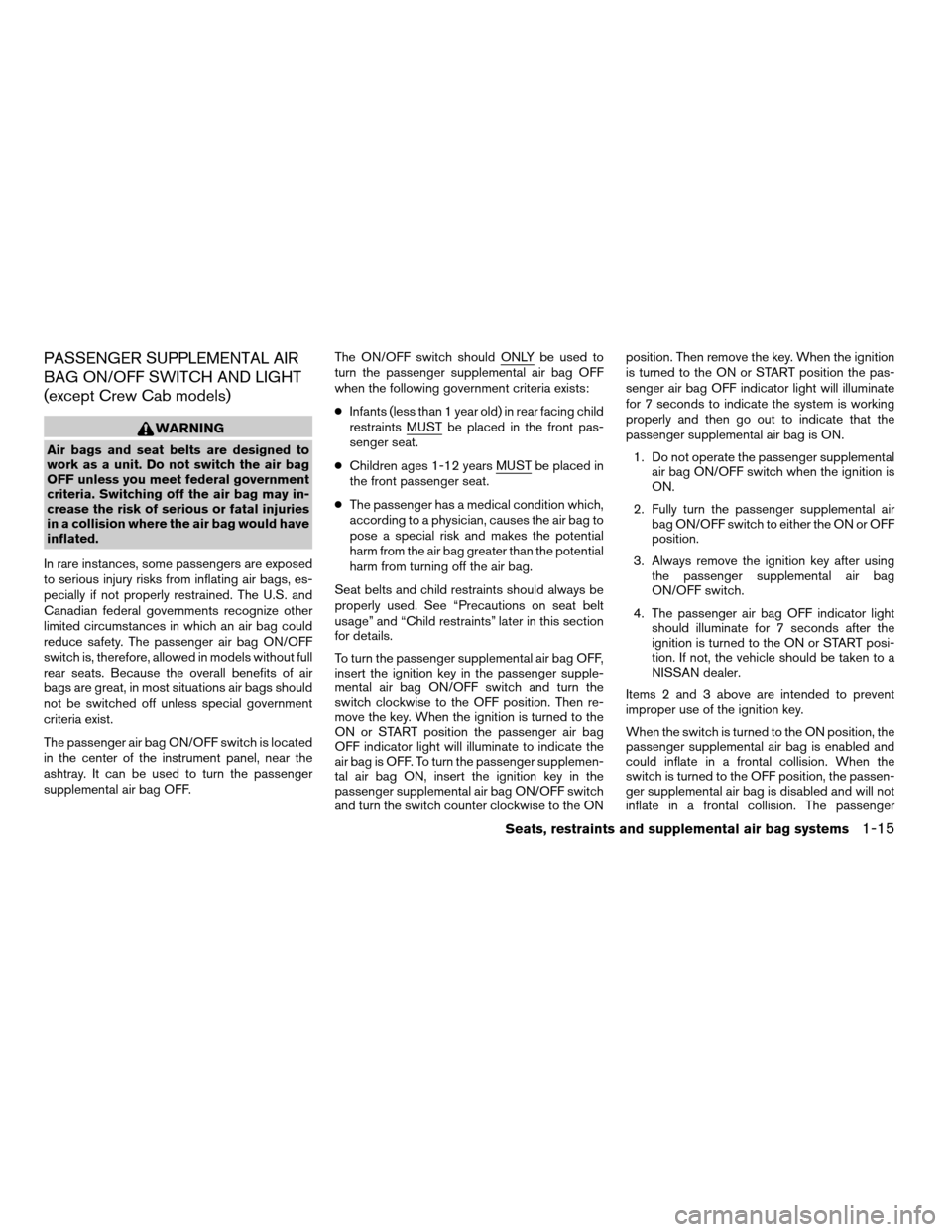
PASSENGER SUPPLEMENTAL AIR
BAG ON/OFF SWITCH AND LIGHT
(except Crew Cab models)
WARNING
Air bags and seat belts are designed to
work as a unit. Do not switch the air bag
OFF unless you meet federal government
criteria. Switching off the air bag may in-
crease the risk of serious or fatal injuries
in a collision where the air bag would have
inflated.
In rare instances, some passengers are exposed
to serious injury risks from inflating air bags, es-
pecially if not properly restrained. The U.S. and
Canadian federal governments recognize other
limited circumstances in which an air bag could
reduce safety. The passenger air bag ON/OFF
switch is, therefore, allowed in models without full
rear seats. Because the overall benefits of air
bags are great, in most situations air bags should
not be switched off unless special government
criteria exist.
The passenger air bag ON/OFF switch is located
in the center of the instrument panel, near the
ashtray. It can be used to turn the passenger
supplemental air bag OFF.The ON/OFF switch should ONLY be used to
turn the passenger supplemental air bag OFF
when the following government criteria exists:
cInfants (less than 1 year old) in rear facing child
restraints MUST be placed in the front pas-
senger seat.
cChildren ages 1-12 years MUST be placed in
the front passenger seat.
cThe passenger has a medical condition which,
according to a physician, causes the air bag to
pose a special risk and makes the potential
harm from the air bag greater than the potential
harm from turning off the air bag.
Seat belts and child restraints should always be
properly used. See “Precautions on seat belt
usage” and “Child restraints” later in this section
for details.
To turn the passenger supplemental air bag OFF,
insert the ignition key in the passenger supple-
mental air bag ON/OFF switch and turn the
switch clockwise to the OFF position. Then re-
move the key. When the ignition is turned to the
ON or START position the passenger air bag
OFF indicator light will illuminate to indicate the
air bag is OFF. To turn the passenger supplemen-
tal air bag ON, insert the ignition key in the
passenger supplemental air bag ON/OFF switch
and turn the switch counter clockwise to the ONposition. Then remove the key. When the ignition
is turned to the ON or START position the pas-
senger air bag OFF indicator light will illuminate
for 7 seconds to indicate the system is working
properly and then go out to indicate that the
passenger supplemental air bag is ON.
1. Do not operate the passenger supplemental
air bag ON/OFF switch when the ignition is
ON.
2. Fully turn the passenger supplemental air
bag ON/OFF switch to either the ON or OFF
position.
3. Always remove the ignition key after using
the passenger supplemental air bag
ON/OFF switch.
4. The passenger air bag OFF indicator light
should illuminate for 7 seconds after the
ignition is turned to the ON or START posi-
tion. If not, the vehicle should be taken to a
NISSAN dealer.
Items 2 and 3 above are intended to prevent
improper use of the ignition key.
When the switch is turned to the ON position, the
passenger supplemental air bag is enabled and
could inflate in a frontal collision. When the
switch is turned to the OFF position, the passen-
ger supplemental air bag is disabled and will not
inflate in a frontal collision. The passenger
Seats, restraints and supplemental air bag systems1-15
ZREVIEW COPY:Ð2003 Truck/Frontier(d22)
Owners Manual(owners)ÐUSA English(nna)
01/13/03Ðarosenma
X
Page 22 of 272
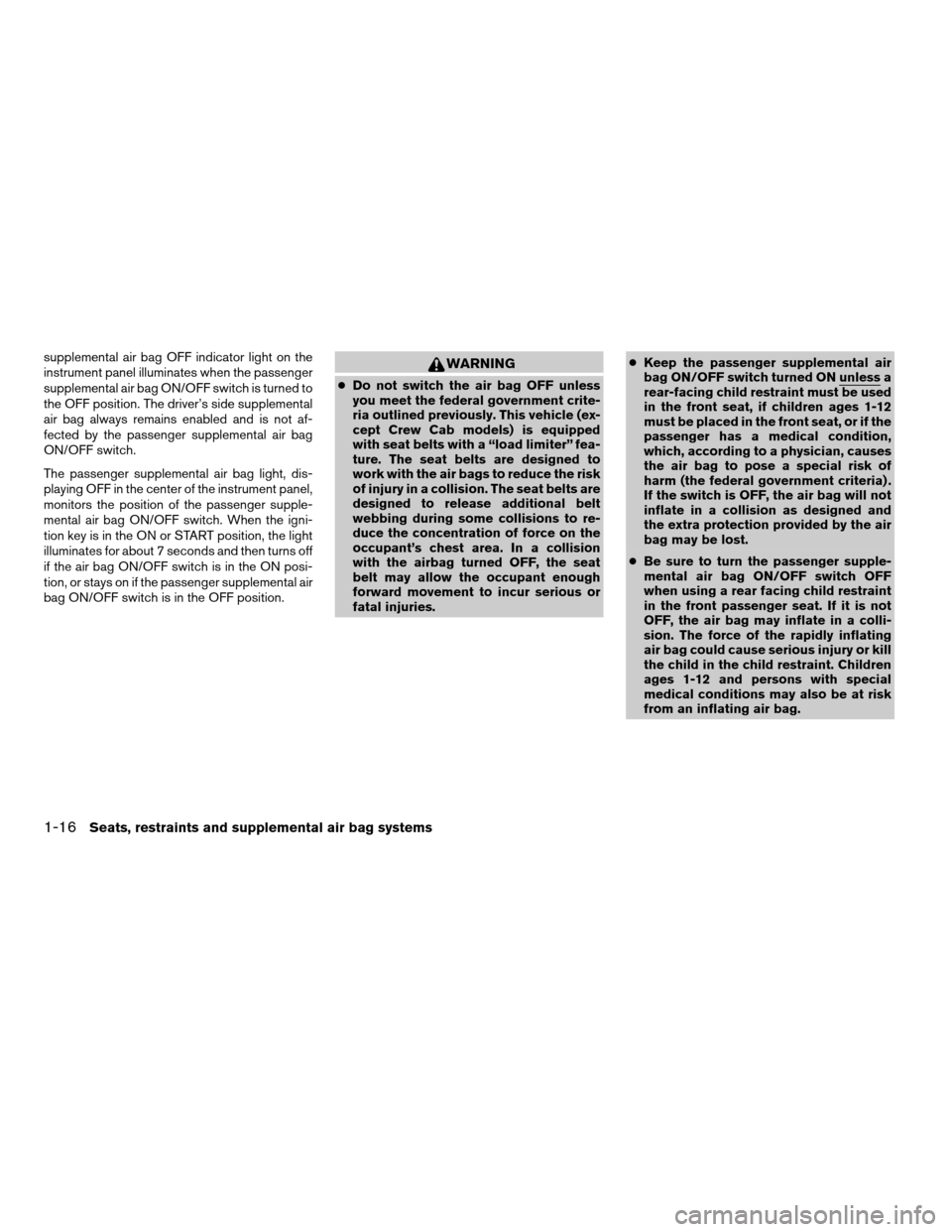
supplemental air bag OFF indicator light on the
instrument panel illuminates when the passenger
supplemental air bag ON/OFF switch is turned to
the OFF position. The driver’s side supplemental
air bag always remains enabled and is not af-
fected by the passenger supplemental air bag
ON/OFF switch.
The passenger supplemental air bag light, dis-
playing OFF in the center of the instrument panel,
monitors the position of the passenger supple-
mental air bag ON/OFF switch. When the igni-
tion key is in the ON or START position, the light
illuminates for about 7 seconds and then turns off
if the air bag ON/OFF switch is in the ON posi-
tion, or stays on if the passenger supplemental air
bag ON/OFF switch is in the OFF position.WARNING
cDo not switch the air bag OFF unless
you meet the federal government crite-
ria outlined previously. This vehicle (ex-
cept Crew Cab models) is equipped
with seat belts with a “load limiter” fea-
ture. The seat belts are designed to
work with the air bags to reduce the risk
of injury in a collision. The seat belts are
designed to release additional belt
webbing during some collisions to re-
duce the concentration of force on the
occupant’s chest area. In a collision
with the airbag turned OFF, the seat
belt may allow the occupant enough
forward movement to incur serious or
fatal injuries.cKeep the passenger supplemental air
bag ON/OFF switch turned ON unless arear-facing child restraint must be used
in the front seat, if children ages 1-12
must be placed in the front seat, or if the
passenger has a medical condition,
which, according to a physician, causes
the air bag to pose a special risk of
harm (the federal government criteria) .
If the switch is OFF, the air bag will not
inflate in a collision as designed and
the extra protection provided by the air
bag may be lost.
cBe sure to turn the passenger supple-
mental air bag ON/OFF switch OFF
when using a rear facing child restraint
in the front passenger seat. If it is not
OFF, the air bag may inflate in a colli-
sion. The force of the rapidly inflating
air bag could cause serious injury or kill
the child in the child restraint. Children
ages 1-12 and persons with special
medical conditions may also be at risk
from an inflating air bag.
1-16Seats, restraints and supplemental air bag systems
ZREVIEW COPY:Ð2003 Truck/Frontier(d22)
Owners Manual(owners)ÐUSA English(nna)
01/13/03Ðarosenma
X